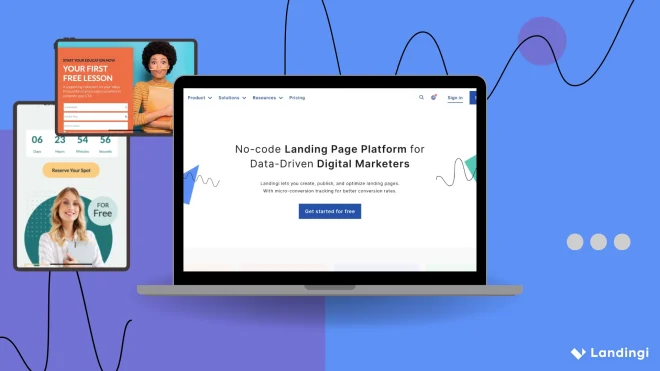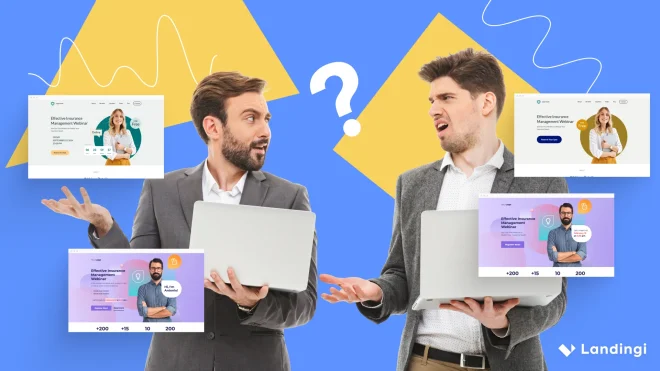The difference between a landing page and a homepage comes down to purpose and focus. Each serves a unique purpose and is crucial in guiding potential customers toward conversions. While the homepage is designed to inform and showcase your brand as a whole, a dedicated landing page is laser-focused on driving specific actions. If you’re wondering what separates these two, you’re in for a comprehensive breakdown.
But before we dive into differences, let’s set the stage with some eye-opening stats about landing pages.
- Increasing the number of landing pages from 10 to 15 can boost conversions by 55% (HubSpot).
- Nearly 48% of marketers create a new landing page for every campaign, knowing the power of tailored experiences (WordStream).
- 43.6% of businesses rely on landing pages to generate leads, making them a cornerstone of modern marketing strategies (HubSpot).
These numbers make it clear—landing pages are essential for driving results. Now, let’s explore the most important differences between landing pages and home pages to help you make the most of each.

What is a Landing Page?
A landing page is a standalone web page designed with a single goal: conversion. Every detail, from the headline to the CTA button, works together to drive a specific action.
Landing pages are often used to promote eBook downloads, gather sign-ups for webinars, announce new products or services, or offer discounts. However, they are not always about selling—sometimes, landing pages are about communicating a message clearly and effectively.
Here’s a high-converting landing page example: the Call Doctor template. This sleek and professional design is just one of over 400 customizable templates available at Landingi.

While every landing page varies depending on the industry, target audience, and main goal, some elements remain universal. These components work together to create landing pages that are engaging, persuasive, and conversion-driven:
Key elements of a high-converting landing page
- Clear, action-oriented call-to-action (CTA) button.
- Captivating headline that grabs attention.
- Supporting subheadline offering additional context.
- Unique selling point (USP) highlighting what makes the offer stand out.
- Engaging visuals, such as hero images or videos.
- Benefits section focused on what the visitor gains.
- Social proof, including testimonials or trust badges.
- Simple lead capture form for collecting essential information.
- Compelling closing statement to reinforce the offer’s value.
Start with the right tools if you want your campaigns to succeed. This landing page guide gives you all the tips and tricks you need to create pages that get results.
What is a Homepage?
A homepage is the central entry point to your website, serving as a digital welcome mat for visitors. It’s designed to introduce your brand, showcase a wide range of services or products, and guide visitors to other pages like an online store, contact page, or blog.

The homepage is the first impression many visitors will have, making it a critical tool for building trust and credibility. A well-designed homepage highlights your brand’s core values and directs users to explore further with intuitive navigation and engaging visuals. Homepages often serve as a central hub for various marketing efforts, linking organic traffic, paid ads, and social media campaigns to relevant website sections. They encourage visitors to stay longer and explore what your brand offers by giving a seamless user experience.
5 Key Differences Between Landing Pages and Homepages
Landing pages and homepages differ in purpose, design, traffic sources, navigation, and conversion rates. Understanding these differences is key to effectively leveraging both types of pages in your marketing strategy.
Below, we’ve outlined the five core distinctions to help you determine when to use each one for maximum impact.
#1 Purpose
Landing pages are laser-focused on one specific goal—whether it’s getting visitors to sign up for a newsletter, buy a product, or download an app. Everything on the page is designed to guide visitors toward that action. Homepages serve as a gateway to your brand, giving visitors an overview of your company and products. They offer a broader look at your offerings and provide links to different sections, so users can explore what interests them.
Landing Pages: focused on a specific goal, like generating leads or promoting a product.
Homepages: provide an overview of your brand’s offerings and guide users to various sections.
Design a landing page in minutes and start driving measurable results
#2 Design
Landing pages are all about keeping things simple and to the point. With a minimalist design and one clear CTA, they direct visitors’ attention to a specific action. No distractions, just results. Homepages are more complex —they typically have multiple CTAs, a navigation menu, and links to different parts of the site, offering visitors several paths to explore your brand further.
Landing Pages
Minimalist, with one clear call to action.
Homepages
Feature multiple CTAs, navigation menus, and links to different pages.
#3 Traffic Sources
Landing pages are directly tied to marketing campaigns like paid ads, email promotions, or special offers. Designed for a specific target audience, they focus on one clear goal, making visitors from channels like Google Ads far more likely to convert. By contrast, homepages attract traffic from broader sources like organic search, social media, and direct visits. While these web pages offer a general overview of your brand, they’re less focused, meaning visitors often browse rather than act. This is why landing pages are the go-to choice for driving specific results.
Landing Pages
Often tied to paid ads, email campaigns, or specific marketing campaigns.
Homepages
Receive traffic from organic search traffic, social media, and direct visitors.
#4 Navigation
Landing pages are designed to keep users focused on one goal, so they don’t have a navigation bar. This helps prevent distractions and directs users straight to the action you want them to take. Homepages have a full navigation menu, allowing users to explore different sections of the website, whether it’s products, blogs, or contact information.
Landing Pages
No navigation bar, keeping users focused.
Homepages
Full navigation to help users explore the website.
#5 Conversion Rates
Landing pages are designed with a single goal in mind, so they usually have higher conversion rates. Every part of the page is focused on getting visitors to take one action, like signing up or making a purchase. In fact, landing pages across industries have a median conversion rate of 6.6% (Unbounce), showing just how effective they can be. Homepages tend to have lower conversion rates because they target a wider audience, and visitors might not be ready to act right away.
Landing Pages
Higher, thanks to their focused character.
Homepages
Lower, as they cater to a wider audience.
Knowing when to use a landing page and when to lean on your homepage can make all the difference in your marketing strategy.
Landing Page Vs. Homepage Examples
Landing pages and homepages may share the same digital space, but they’re built to do completely different jobs. We’ll look at real examples to see how each page serves its purpose and gets things done.
Landing Page Examples
A landing page like the one on Hip2Keto is all about keeping it simple. With a clear offer of 20 keto recipes, the page guides you straight to signing up. No extra fluff, just one goal and a quick, easy path to get there.

What makes it work? The design is clean, the messaging is sharp, and the call to action feels like a no-brainer. The form doesn’t overcomplicate things; it’s quick to fill out and gets you straight to the reward. Another smart move – the layout respects your time. No distractions, no endless scrolling, just a clean, direct form that gets to-the-point.
Want to see more smart and inspiring designs? Dive into these landing page examples for ideas you can bring to life in your campaigns!
Homepage Examples
On L’Oursin’s homepage, everything is clear and easy to navigate. Whether you’re looking for specific details or just browsing, the design makes it simple to get what you need in no time.

You can quickly check out the menu, read about the restaurant, find directions, or explore reviews.

Every section feels intuitive, giving you exactly what you want in a few moments. It’s a seamless experience from start to finish.
Test our landing page builder for free and discover how easy it is to capture leads
When to Use a Landing Pages?
Use a landing page when you need to focus on a single, clear objective. Whether promoting paid campaigns, gathering sign-ups for an email list, or driving downloads for an eBook, landing pages focus entirely on the desired action.
Here are some practical use cases:
- Paid advertising campaigns (e.g., Google Ads, Facebook Ads)
- Lead generation through forms (e.g., for eBooks, webinars, free trials)
- Product or service launches
- Event registrations (e.g., webinars, workshops, conferences)
- Promotions and exclusive discounts
- Waitlists or beta access sign-ups
- App downloads with targeted messaging
- Surveys or feedback collection
- Fundraising or donations for nonprofits
- Driving sign-ups for loyalty programs or memberships
When to Use a Homepages?
Use a homepage when you need to give visitors an overview of your brand and guide them to different pages. This could include an about page, service descriptions, or contact information.
However, its general nature means a homepage isn’t built for a single, focused goal. A landing page works best when you need to target a specific audience with a tailored message. Its clarity and precision are what make it an essential tool for achieving measurable results. The homepage lays the foundation, but the landing pages deliver precision and purpose.
Experience the difference a well-crafted landing page can make for your business
Should My Landing Page Be My Home Page?
No, your landing page should not be your homepage, and here’s why.
Homepages and landing pages are designed to achieve different goals. A homepage introduces your brand, providing visitors with an overview and directing them to various sections. It’s broad by design, catering to a wide audience. Landing pages are built for focus. Their primary purpose is to drive a specific action. Combining these two roles can dilute their effectiveness.
To maximize results, keep your landing pages separate and goal-oriented. Each page serves its purpose best when it’s tailored to meet the unique needs of your audience at different stages of their journey.
What are the Limitations of Landing Pages?
Landing pages are laser-focused—and that’s both their strength and weakness. They lack the broad range of information found on a homepage, which can limit user engagement beyond the specific campaign goal. But that’s exactly what makes them so effective. A well-designed landing page cuts through the noise, guiding users toward one clear action without distractions.
Looking for inspiration? Landingi offers over 400 professionally designed templates to help you create stunning landing pages in minutes. No coding is required—just drag, drop, and publish!

Another common concern is their reliance on specific traffic sources, like paid ads or email campaigns. If the audience isn’t right, the page might not perform as well as expected. The good news? When your landing page is tailored to match the needs of your audience—through precise targeting, engaging content, and a strong call to action—it becomes a powerful tool that drives measurable results.
At Landingi, we believe every landing page should feel like it was made just for the person visiting it. With the right strategy and design, even landing pages’ so-called “limitations” can become opportunities to create seamless, conversion-focused experiences.
What are the Limitations of Homepages?
Homepages’ limitations lie in their focus on providing general information rather than driving conversions. Multiple CTAs and links can overwhelm visitors, making it harder for them to decide on that next step—whether it’s signing up or making a purchase. The wide focus means visitors might get lost in the options, and without a clear direction, the homepage can’t always drive the conversions you’re after.
Create Landing Pages with Landingi
Both landing pages and homepages play vital roles in your marketing toolbox. Homepages set the stage, offering visitors a broad introduction to your brand, while landing pages take center stage when it’s time to convert curiosity into action. Mastering the balance between these two is the key to a seamless user journey and, ultimately, better results.
Ready to take your campaigns to the next level? With Landingi, creating high-performing landing pages has never been easier. Start building pages that captivate, convert, and deliver results that speak for themselves. Try now!






